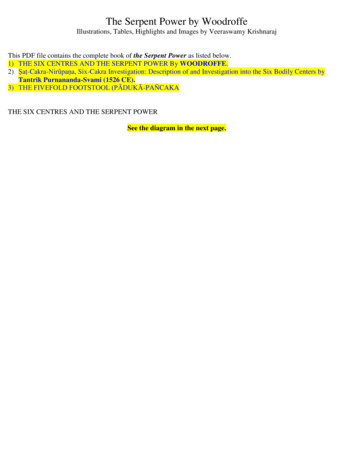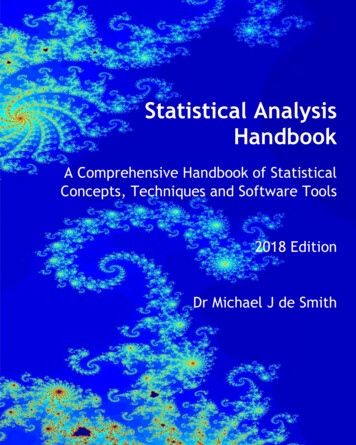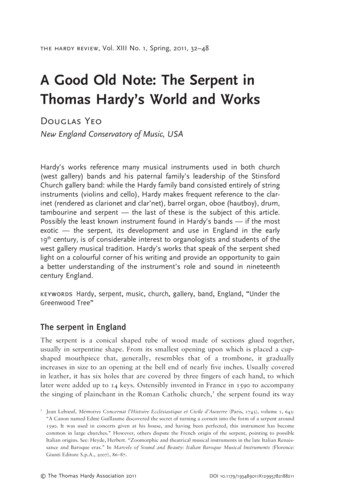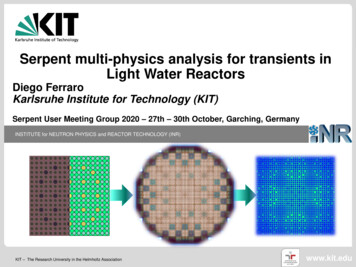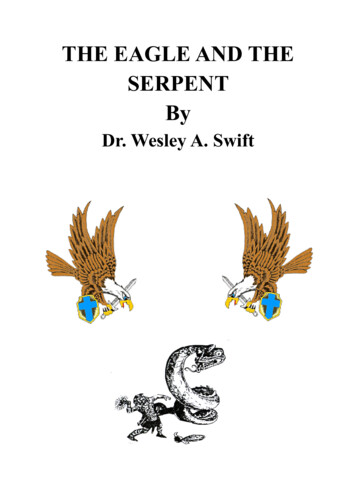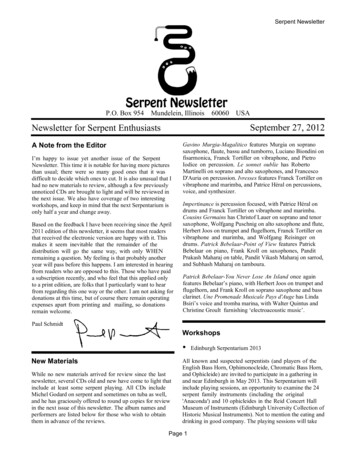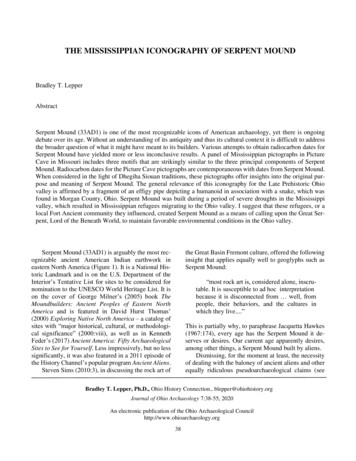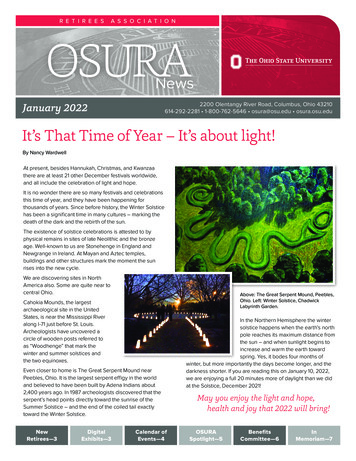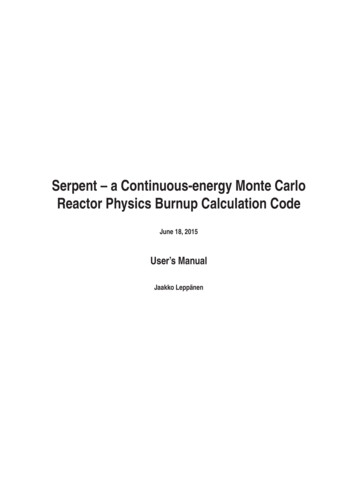
Transcription
Serpent – a Continuous-energy Monte CarloReactor Physics Burnup Calculation CodeJune 18, 2015User’s ManualJaakko Leppänen
PrefaceThis documentation is a User’s Manual for the Serpent continuous-energy Monte Carlo reactor physics burnup calculation code.1 Code development started at the VTT Technical Research Centre of Finland in 2004, under the working title “Probabilistic Scattering Game”,or PSG. This name is used in all publications dated before the pre-release of Serpent 1.0.0in October 2008. The name was changed to due to the various ambiguities related to theacronym. The code is still under development and this manual covers only the main functionality available in June 18.The official Serpent website is found at http://montecarlo.vtt.fi. Support and minor updatesin the source code are currently handled via the Serpent mailing list, in which all users areencouraged to join by sending e-mail to: Jaakko.Leppanen@vtt.fi. Any feedback is appreciated, including comments, bug reports, interesting results and ideas and suggestions for future development. A discussion forum for Serpent users is found at http://ttuki.vtt.fi/serpent.For a quick start, experienced Monte Carlo code users are instructed to view the lattice inputexamples in Chapter 11 starting on page 133.1For referencing the code, use either the website: “http://montecarlo.vtt.fi” or this report: “J. Leppänen. Serpent – a Continuous-energy Monte Carlo Reactor Physics Burnup Calculation Code. VTT Technical ResearchCentre of Finland. (June 18, 2015)”2
ContentsPreface21 Installing and Running Serpent81.1Compiling Serpent . . . . . . . . . . . . . . . . . . . . . . . . . . . . . .81.2Running the Code . . . . . . . . . . . . . . . . . . . . . . . . . . . . . . .91.3Parallel Calculation . . . . . . . . . . . . . . . . . . . . . . . . . . . . . .101.4Nuclear Data . . . . . . . . . . . . . . . . . . . . . . . . . . . . . . . . .111.4.1Data Types . . . . . . . . . . . . . . . . . . . . . . . . . . . . . .111.4.2Directory File . . . . . . . . . . . . . . . . . . . . . . . . . . . . .121.4.3Radioactive Decay and Fission Yield Data . . . . . . . . . . . . . .132 Input152.1General . . . . . . . . . . . . . . . . . . . . . . . . . . . . . . . . . . . .152.2Input format . . . . . . . . . . . . . . . . . . . . . . . . . . . . . . . . . .152.2.1Input cards . . . . . . . . . . . . . . . . . . . . . . . . . . . . . .152.2.2Comment lines and sections . . . . . . . . . . . . . . . . . . . . .162.2.3Dividing the input into several files . . . . . . . . . . . . . . . . . .162.2.4Input errors . . . . . . . . . . . . . . . . . . . . . . . . . . . . . .17Units . . . . . . . . . . . . . . . . . . . . . . . . . . . . . . . . . . . . . .182.33 Geometry193.1The Universe-based Geometry Model in Serpent . . . . . . . . . . . . . . .193.2Surface Definitions . . . . . . . . . . . . . . . . . . . . . . . . . . . . . .193.2.1Surface types . . . . . . . . . . . . . . . . . . . . . . . . . . . . .203.2.2Positive and negative surface sides . . . . . . . . . . . . . . . . . .213.2.3Surface examples . . . . . . . . . . . . . . . . . . . . . . . . . . .22Cell Definitions . . . . . . . . . . . . . . . . . . . . . . . . . . . . . . . .243.33
CONTENTS43.3.1Cell types . . . . . . . . . . . . . . . . . . . . . . . . . . . . . . .243.3.2Cell examples . . . . . . . . . . . . . . . . . . . . . . . . . . . . .253.4Fuel pin definitions . . . . . . . . . . . . . . . . . . . . . . . . . . . . . .273.5Nests . . . . . . . . . . . . . . . . . . . . . . . . . . . . . . . . . . . . . .273.6Universes and Lattices . . . . . . . . . . . . . . . . . . . . . . . . . . . .283.6.1Universe transformations and rotations . . . . . . . . . . . . . . . .283.6.2Lattices . . . . . . . . . . . . . . . . . . . . . . . . . . . . . . . .293.6.3Universe and lattice examples . . . . . . . . . . . . . . . . . . . .323.7Repeated Boundary Conditions . . . . . . . . . . . . . . . . . . . . . . . .363.8HTGR geometry types . . . . . . . . . . . . . . . . . . . . . . . . . . . .393.8.1Implicit particle fuel model . . . . . . . . . . . . . . . . . . . . . .393.8.2Explicit particle / pebble bed fuel model . . . . . . . . . . . . . . .403.8.3HTGR geometry examples . . . . . . . . . . . . . . . . . . . . . .41Geometry plotter . . . . . . . . . . . . . . . . . . . . . . . . . . . . . . .423.94 Materials4.147Material definitions . . . . . . . . . . . . . . . . . . . . . . . . . . . . . .474.1.1Nuclides . . . . . . . . . . . . . . . . . . . . . . . . . . . . . . . .474.1.2Material cards . . . . . . . . . . . . . . . . . . . . . . . . . . . . .484.2Thermal scattering libraries . . . . . . . . . . . . . . . . . . . . . . . . . .494.3Doppler broadening . . . . . . . . . . . . . . . . . . . . . . . . . . . . . .504.4Material examples . . . . . . . . . . . . . . . . . . . . . . . . . . . . . . .505 Options535.1General . . . . . . . . . . . . . . . . . . . . . . . . . . . . . . . . . . . .535.2Neutron Population and Criticality Cycles . . . . . . . . . . . . . . . . . .535.3Energy grid reconstruction . . . . . . . . . . . . . . . . . . . . . . . . . .555.4Library File Paths . . . . . . . . . . . . . . . . . . . . . . . . . . . . . . .575.5Unresolved resonance data . . . . . . . . . . . . . . . . . . . . . . . . . .575.6Doppler-Broadening Rejection Correction (DBRC) . . . . . . . . . . . . .595.7Boundary conditions . . . . . . . . . . . . . . . . . . . . . . . . . . . . .595.8Source rate normalization . . . . . . . . . . . . . . . . . . . . . . . . . . .615.9Group constant generation . . . . . . . . . . . . . . . . . . . . . . . . . .64
CONTENTS55.10 Full-core power distributions . . . . . . . . . . . . . . . . . . . . . . . . .665.11 Delta-tracking options . . . . . . . . . . . . . . . . . . . . . . . . . . . . .665.12 Cross section data plotter . . . . . . . . . . . . . . . . . . . . . . . . . . .685.13 Fission source entropy . . . . . . . . . . . . . . . . . . . . . . . . . . . .685.14 Soluble absorber . . . . . . . . . . . . . . . . . . . . . . . . . . . . . . . .695.15 Iteration . . . . . . . . . . . . . . . . . . . . . . . . . . . . . . . . . . . .705.16 Fundamental mode calculation . . . . . . . . . . . . . . . . . . . . . . . .715.17 Equilibrium xenon calculation . . . . . . . . . . . . . . . . . . . . . . . .725.18 Miscellaneous parameters . . . . . . . . . . . . . . . . . . . . . . . . . . .736 Output776.1Main output file . . . . . . . . . . . . . . . . . . . . . . . . . . . . . . . .776.1.1Version, title and date . . . . . . . . . . . . . . . . . . . . . . . . .786.1.2Run parameters . . . . . . . . . . . . . . . . . . . . . . . . . . . .786.1.3File paths . . . . . . . . . . . . . . . . . . . . . . . . . . . . . . .796.1.4Delta-tracking parameters . . . . . . . . . . . . . . . . . . . . . .796.1.5Run statistics . . . . . . . . . . . . . . . . . . . . . . . . . . . . .806.1.6Energy grid parameters . . . . . . . . . . . . . . . . . . . . . . . .806.1.7Unresolved resonance data . . . . . . . . . . . . . . . . . . . . . .816.1.8Nuclides and reaction channels . . . . . . . . . . . . . . . . . . . .816.1.9Reaction mode counters . . . . . . . . . . . . . . . . . . . . . . .826.1.10 Slowing-down and thermalization . . . . . . . . . . . . . . . . . .826.1.11 Parameters for burnup calculation . . . . . . . . . . . . . . . . . .836.1.12 Fission source entropies . . . . . . . . . . . . . . . . . . . . . . .836.1.13 Fission source center . . . . . . . . . . . . . . . . . . . . . . . . .846.1.14 Soluble absorber . . . . . . . . . . . . . . . . . . . . . . . . . . .846.1.15 Iteration . . . . . . . . . . . . . . . . . . . . . . . . . . . . . . . .846.1.16 Equilibrium Xe-135 calculation . . . . . . . . . . . . . . . . . . .846.1.17 Criticality eigenvalues . . . . . . . . . . . . . . . . . . . . . . . .856.1.18 Normalization . . . . . . . . . . . . . . . . . . . . . . . . . . . . .866.1.19 Point-kinetic parameters . . . . . . . . . . . . . . . . . . . . . . .876.1.20 Six-factor formula . . . . . . . . . . . . . . . . . . . . . . . . . .87
CONTENTS6.266.1.21 Delayed neutron parameters . . . . . . . . . . . . . . . . . . . . .876.1.22 Parameters for group constant generation . . . . . . . . . . . . . .886.1.23 Few-group cross sections . . . . . . . . . . . . . . . . . . . . . . .886.1.24 Fission product poison cross sections . . . . . . . . . . . . . . . . .896.1.25 Fission spectra . . . . . . . . . . . . . . . . . . . . . . . . . . . .906.1.26 Group-transfer probabilities and cross sections . . . . . . . . . . .906.1.27 Diffusion parameters . . . . . . . . . . . . . . . . . . . . . . . . .906.1.28 Pn scattering cross sections . . . . . . . . . . . . . . . . . . . . . .916.1.29 P1 diffusion parameters . . . . . . . . . . . . . . . . . . . . . . . .916.1.30 B1 fundamental mode calculation . . . . . . . . . . . . . . . . . .926.1.31 Assembly discontinuity factors . . . . . . . . . . . . . . . . . . . .936.1.32 Power distributions in lattices . . . . . . . . . . . . . . . . . . . . .93History output . . . . . . . . . . . . . . . . . . . . . . . . . . . . . . . . .947 Detectors7.195Detector Input . . . . . . . . . . . . . . . . . . . . . . . . . . . . . . . . .957.1.1Setting the Response Function . . . . . . . . . . . . . . . . . . . .967.1.2Setting the Energy Domain . . . . . . . . . . . . . . . . . . . . . .997.1.3Setting the Spatial Domain . . . . . . . . . . . . . . . . . . . . . .1017.1.4Surface Current Detectors . . . . . . . . . . . . . . . . . . . . . .1047.2Detector output . . . . . . . . . . . . . . . . . . . . . . . . . . . . . . . .1057.3Detectors in Burnup Calculation . . . . . . . . . . . . . . . . . . . . . . .1078 Burnup calculation1088.1General . . . . . . . . . . . . . . . . . . . . . . . . . . . . . . . . . . . .1088.2Depleted materials . . . . . . . . . . . . . . . . . . . . . . . . . . . . . . .1098.3Irradiation history . . . . . . . . . . . . . . . . . . . . . . . . . . . . . . .1108.4Options for Burnup Calculation . . . . . . . . . . . . . . . . . . . . . . . .1118.4.1Library File Paths . . . . . . . . . . . . . . . . . . . . . . . . . . .1118.4.2Normalization . . . . . . . . . . . . . . . . . . . . . . . . . . . . .1128.4.3Solution of Depletion Equations . . . . . . . . . . . . . . . . . . .1138.4.4Calculation of Transmutation Cross Sections . . . . . . . . . . . .113
CONTENTS78.4.5Cut-offs . . . . . . . . . . . . . . . . . . . . . . . . . . . . . . . .1148.4.6Nuclide Inventory . . . . . . . . . . . . . . . . . . . . . . . . . . .1148.4.7Additional Output . . . . . . . . . . . . . . . . . . . . . . . . . . .1158.4.8Decay heat production in multiple precursor groups . . . . . . . . .1158.5Output in independent mode . . . . . . . . . . . . . . . . . . . . . . . . .1168.6Output in coupled mode . . . . . . . . . . . . . . . . . . . . . . . . . . . .1178.7Burnup calculation examples . . . . . . . . . . . . . . . . . . . . . . . . .1178.7.1Material and lattice examples . . . . . . . . . . . . . . . . . . . . .1178.7.2Irradiation history examples . . . . . . . . . . . . . . . . . . . . .1219 External Source Mode1259.1General . . . . . . . . . . . . . . . . . . . . . . . . . . . . . . . . . . . .1259.2Source definition . . . . . . . . . . . . . . . . . . . . . . . . . . . . . . .1269.2.1Setting the Spatial Distribution . . . . . . . . . . . . . . . . . . . .1269.2.2Setting the Directional Distribution . . . . . . . . . . . . . . . . . .1289.2.3Setting the Energy Distribution . . . . . . . . . . . . . . . . . . . .1289.2.4Source files . . . . . . . . . . . . . . . . . . . . . . . . . . . . . .129Source Examples . . . . . . . . . . . . . . . . . . . . . . . . . . . . . . .1299.310 Reaction rate mesh plotter13110.1 Mesh input . . . . . . . . . . . . . . . . . . . . . . . . . . . . . . . . . . .13110.2 Mesh output . . . . . . . . . . . . . . . . . . . . . . . . . . . . . . . . . .13211 Complete Input Examples13311.1 Quick start . . . . . . . . . . . . . . . . . . . . . . . . . . . . . . . . . . .13311.1.1 VVER-440 lattice calculation . . . . . . . . . . . . . . . . . . . . .13411.1.2 BWR lattice calculation . . . . . . . . . . . . . . . . . . . . . . . .13711.1.3 CANDU lattice calculation . . . . . . . . . . . . . . . . . . . . . .14211.1.4 Mixed UOX/MOX PWR lattice calculation . . . . . . . . . . . . .14511.2 Burnup calculation examples . . . . . . . . . . . . . . . . . . . . . . . . .15011.2.1 Pin-cell burnup calculation . . . . . . . . . . . . . . . . . . . . . .15011.2.2 PWR assembly burnup calculation . . . . . . . . . . . . . . . . . .153Bibliography162
Chapter 1Installing and Running Serpent1.1Compiling SerpentThe Serpent code is written in standard ANSI-C language. The code is mainly developedin the Linux operating system, but it has also been compiled and tested in MAC OS X andsome UNIX machines.1 The Monte Carlo method is a computing-intensive calculation technique and raw computing power has a direct impact on the overall calculation time. It shouldbe taken into account that the unionized energy grid format used in Serpent requires morecomputer memory compared to other continuous-energy Monte Carlo codes. One gigabyteof RAM should be sufficient for steady-state calculations, but a minimum of 3 Gb is recommended for burnup calculation.The source code is compiled simply by running the GNU Make utility.2 The Makefile provides for detailed instructions and various options for different platforms. Serpent uses theGD open source graphics library [1] for producing some graphical output. If this library isnot installed in the system, the source code must be compiled with the “NO GFX MODE”option. The compilation should not result in any errors or warning messages and it shouldproduce an executable named “sss”. Any problems in installation should be reported bye-mail to: Jaakko.Leppanen@vtt.fi.Code updates are provided to registered users by distributing the updated source files bye-mail. New files replace old ones and the code must be re-compiled for the changes to takeeffect.1The main platforms in PSG/Serpent development have been a 2.6 GHz dual-core AMD Opteron PC with5 Gb RAM running Fedora Core 4 and an iBook G4 with 1.2 GHz PowerPC processor and 768 Mb RAMrunning OS X v10.4.2For a detailed description of Makefiles, see: http://www.gnu.org/software/make.8
1.2 Running the Code1.29Running the CodeAll interaction between the code and the user is handled through one or several input filesand various output files, as described in the following chapters. The code is run from thecommand line interface. The general syntax is:sss inputfile [ options ]where inputfile options is the name of the main input fileare the optionsThe input file is a standard text file containing the input description. The input can also bedivided into several files which are referred to in the main file.The available options are:print version information and exitrun the simulation using random number seed fromprevious calculation-plotterminate run after geometry plot-testgeom N test the geometry using N randomly sampledneutron tracks-checkvolumes N calculate Monte Carlo estimates for materialvolumes by sampling N random points-mpi N run simulation in parallel mode (see Sec. 1.3)-dispersegenerate random particle or pebble distributionfiles for HTGR calculations-version-replayThe replay option forces the code to use the same random number seed as in a previous run.Without this option, the seed is taken from system time and written in a separate seed file(named inputfile .seed) for later use. The seed can also be set manually in the inputusing the “set seed” option.3The geometry test option can be used for debugging the geometry in addition to the geometryplotter. The code randomly samples neutron tracks across the geometry and checks that thecells are correctly defined. Some input errors can spotted using this option.The volume checking option can be used to verify that the volumes used in the calculationare correct. The code is able to calculate cell volumes for simple lattice geometries, butsome more complicated geometry types require the values to be set by the user. The volumes3The results of a Monte Carlo calculation depend on the sequence of pseudo random numbers used duringthe simulation. This sequence is fixed by the random number seed and the calculation can be repeated using thesame seed. The capability to reproduce the same simulation is important, for example, for debugging purposes.Some codes, such as MCNP [2], use a fixed seed value, which results in the same results every time the code isrun. The Serpent code uses by default a different seed for each run and hence the results are different as well.This behavior can be overridden by the replay command line option or by setting the seed manually in the inputfile.
1.3 Parallel Calculation10are used for normalizing reaction rates for detectors and burnup calculation. The number ofrandom points should be large (at least 1,000,000) for good statistical accuracy.The random particle / pebble distribution generator works by prompting the user informationon the volume type and dimensions, particle data and packing fractions. The code thengenerates a distribution inside the desired volume without overlapping any particles. Thedata is written in a file using format that can be directly read into the explicit HTGR geometrymodel (See Sec. 3.8.2 on page 40). The option is available from code version 1.1.5 on.IMPORTANT NOTES ON RUNNING THE CODE:1. The seed file is overwritten by a new value each time the code is run without the replayoption and the old seed is lost.SEE ALSO:1. Dividing the input into several files (Sec.2.2.3 on page 16)2. Setting the random number seed manually (Sec. 5.18 on page 73)3. Geometry plotter (Sec. 3.9 on page 42)4. Setting material volumes manually (Sec. 4.1.2 on page 49)1.3Parallel CalculationSerpent uses the Message Passing Interface (MPI) [3] for parallel calculation. To activate thiscapability the code must be compiled with the “PARALLEL MPI” option (see the Makefilefor details) and the MPI libraries must be installed on the system.There are two options for running the code in the parallel calculation mode. The first optionis to use the standard MPI tools, such as mpirun:[user@host mpitest] mpirun -np 10 sss inputThis command executes the calculation in 10 hosts as defined in the parallel environment.The second option is to use the built-in MPI runner and define the number of tasks in thecommand line:[user@host mpitest] sss -mpi 10 inputIn this calculation mode, the code attempts to run mpirun on its own. This may require smallmodifications in the source code or may not work at all in some systems. The file path formpirun is defined by the “MPIRUN PATH” precompiler variable in the “header.h” sourcefile.
1.4 Nuclear Data11IMPORTANT NOTES ON PARALLEL CALCULATION:1. Parallel calculation is available from version 1.0.3 on.2. When multiple tasks are sharing the same memory space, the size of allocated memoryis also multiplied. This should be taken into account when setting the memory size inthe compilation.3. The methodology is still under development. The calculation lacks error tolerance andload sharing and the mode should be used only in systems consisting of identical hosts.Most of the MPI routines were directly adopted from PSG and features exclusivelyavailable in Serpent (including burnup calculation) are not thoroughly tested.SEE ALSO:1. The MPI standard: http://www-unix.mcs.anl.gov/mpi/2. The mpirun irun.html1.4Nuclear DataThe Serpent code reads continuous-energy interaction data from ACE format cross sectionlibraries. The current installation package contains libraries based on JEF-2.2, JEFF-3.1,ENDF/B-VI.8 and ENDF/B-VII evaluated data files. Since the data format is shared withMCNP, alternative data for various isotopes should be readily available to most users. Thereare also several ACE format data libraries based on different evaluations publicly availablethrough the OECD/NEA Data Bank [4]. New libraries can be produced from raw ENDFformat data using the NJOY nuclear data processing system [5].1.4.1Data TypesThree types of cross sections are available in the data files. Continuous-energy neutron crosssections (type 1) are used for the actual transport simulation. The data contains all necessaryreaction cross sections, together with energy and angular distributions, fission neutron yieldsand delayed neutron parameters.The second data type is the dosimetry cross section (type 2). Dosimetry cross sections exist for a large variety of materials and may include derived reaction modes not commonlyencountered in transport calculation. The data may consist of one or several partial crosssections, but all energy and angular distributions are omitted. The data can be used withdetectors but not in physical materials included in the transport calculation.
1.4 Nuclear Data12Thermal scattering cross sections (type 3) are used to replace the low-energy free-gas elasticscattering reactions for some important bound moderator nuclides, such as hydrogen in wateror carbon in graphite. Thermal systems cannot be modelled using free-atom cross sectionswithout introducing significant errors in the spectrum and the results.1.4.2Directory FileThe cross section data is accessed by using a separate directory file, which differs from the“xsdir” file commonly used with ACE format data. A conversion between the two formatscan be made by running the “xsdirconvert” utility script, included in the installation package:[user@host xsdata] xsdirconvert.pl data.xsdir data.xsdataThe Serpent directory file contains the data necessary for the code for locating the crosssection libraries and forming the material compositions. Each line in the directory file hasthe following format: alias zaid type ZA I AW T bin path where alias zaid type ZA I AW T bin path is the name identifying the nuclide in the input fileis the actual nuclide name in the datais the type of the datais the isotope identifier (1000*Z A)is the isomeric state number (0 ground state)is the atomic weightis the nuclide temperature (in K)is the binary format flag (0 ASCII, 1 binary)is the data path for the /1001 06.ace/xs/1001 06.ace/xs/8016 06.ace/xs/8016 06.ace/xs/40000 06.ace/xs/40000 06.ace/xs/92235 09.ace/xs/92235 09.ace/xs/92238 09.ace/xs/92238 09.ace/xs/95342 09.ace/xs/95342 09.ace/xs/tmccs1/xs/llldos1
1.4 Nuclear Data93237.30y 93237.30y 2 93237 0 239.10201130.0 0 /xs/llldos1The alias is the nuclide name used in the input file and it may or may not be the same asthe actual isotope name. The xsdirconvert tool writes two entries for each nuclide, one usingthe original name and another one using the element symbol and the isotope number. Thedata types are: 1 continuous-energy, 2 ACE dosimetry. 3 thermal scattering, Thetemperature entry is used with transport data only and the atomic mass with transport anddosimetry cross sections.Isomeric states are identified from the state number4 (see Am-242m in the example). Thereis no standard convention on how to name these isotopes in the ACE format data, but thexsdirconvert-tool assumes that the mass number of isomeric state nuclides is increased above300. If another convention is used, the state number must be set manually in the directoryfile. It is recommended that the isomeric state entries are always carefully checked afterrunning xsdirconvert.1.4.3Radioactive Decay and Fission Yield DataRadioactive decay and fission yield data is needed for running the Serpent code in the independent burnup calculation mode. It is recommended that the libraries are included in thecoupled mode as well, since it enables the data to be reproduced in the output file, making itdirectly available to the coupled calculation.The decay constants and fission product distributions are read from standardized ENDF format data files [6]. The format is directly accessible and the data requires no preprocessing.JEF-2.2, JEFF-3.1, ENDF/B-VI.8 and ENDF/B-VII data libraries are included in the installation package. More data can be downloaded from various Internet sources:– OECD/NEA Data Bank: http://www.nea.fr/html/dbdata/– Los Alamos T2 Nuclear Information Service: http://t2.lanl.gov– US National Nuclear Data Center: http://www.nndc.bnl.gov– US Radiation Safety Information Computational Center:http://www-rsicc.ornl.gov– IAEA Nuclear Data Centre: http://www-nds.iaea.org– JAEA Nuclear Data Center: http://wwwndc.tokai-sc.jaea.go.jpIMPORTANT NOTES ON INTERACTION DATA:4The information on isomeric states is needed for burnup calculation only. All nuclides are treated similarlyin the transport simulation.
1.4 Nuclear Data141. The weight in the directory file is given as the atomic weight, not the atomic weightratio as in MCNP xsdir files.2. The temperature in the directory file is given in Kelvin, not in MeV as in the MCNPxsdir files.3. Binary data is not supported in the current code version.4. The data path in the directory file must refer to the absolute, not the relative locationof the library file.5. The code always uses the first matching entry in the directory file. The use of duplicateisotope names may lead to unexpected results.SEE ALSO:1. Setting up the file paths (Sec.5.4 on page 57)2. Material definitions (Chapter 4 on page 47)
Chapter 2Input2.1GeneralThe Serpent code has no interactive user interface. All communication between the code andthe user is handled through one or several input files and various output files discussed inChapter 6. User-defined detectors are discussed as a separate item in Chapter 7 and burnupcalculation in Chapter 8.2.2Input formatThe format of the input file is unrestricted. The file consists of white-space (space, tab ornewline) separated words, containing alphanumeric characters(’a-z’, ’A-Z’, ’0-9’, ’.’, ’-’).If special characters or white spaces need to be used within the word (file names, etc.), theentire string must be enclosed within quotation marks.2.2.1Input cardsThe input file is divided into separate data blocks, denoted as cards. The file is processedone card at a time and there are no restrictions in what order the cards should be organized.The input cards are listed in Table 2.1 and detailed descriptions are provided in the followingchapters. All input cards and special command words are case-insensitive. Each input card isdelimited by the beginning of the next card. It is hence important that none of the parameterstrings used within the card coincide with the card identifiers in Table 2.1.15
2.2 Input format16Table 2.1: List of commands and input oncell definitionirradiation historydetector definitionimplicit HTGR particle fuel modeldetector energy binningread a new input filelattice definitionmaterial definitionreaction rate mesh plotternest definitionparticle definitionexplicit HTGR particle / pebble bed fuel modelpin definitiongeometry plottermisc. parameter definitionexternal source definitionsurface definitionthermal scattering data definitionuniverse transformationChapter / 131273940274253126204929Comment lines and sectionsThe Serpent code provides two types of comments for the input files. The percent-sign (%)or hash (#) are used to define a comment line. Anything from this character to the end of theline is omitted when the input file is read. The alternative is to use C-style comment sectionsbeginning with “/*” and ending with “*/”. Everything within these delimiters is omitted,regardless of the number of newlines or special characters between them.2.2.3Dividing the input into several filesComplicated input descriptions can be simplified by dividing the cards into separate files.This capability may also be useful if different calculation cases share some partial data.Additional input files are recursively read from the main file using the include-command:include " filename "where filename is the file path for the input fileWhen this command is encountered, the program will first read the included file before
2.2 Input format17continuing with the main file. The number of nested input files is unrestricted. Since filenames and paths often include non-alphanumeric characters, it is good practice to alwaysenclose the strings within quotation marks.2.2.4Input errorsThe Serpent code performs some error checking on the input file before proceeding with thecalculation. These checks include:– Checking that there are an even number of quotation marks.– Checking the correct number of parameters for some input cards.– Checking the type (string, integer, real) of some parameters.– Checking that the values of some parameters are within a reasonable range.– Checking that all cards that are referred to in other cards are defined.– Checking that all referred files exist.– Checking that the input contains sufficient data for running the simulation.– Various checks related to specific input cards.Failure in any of the checks results in an error message and the termination of the calculation.Most common input errors are caused by missing parameters or mistyped command words.In the former case, the result
Preface This documentation is a User’s Manual for the Serpent continuous-energy Monte Carlo re-actor physics burnup calculation code.1 Code development started at the VTT Technical Re- search Centre of Finland in 2004,
